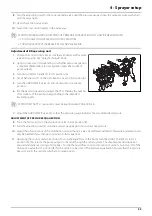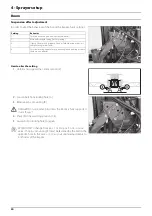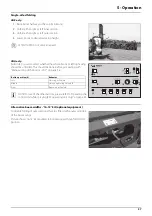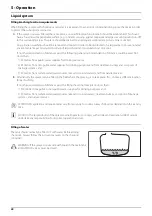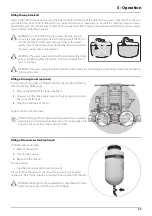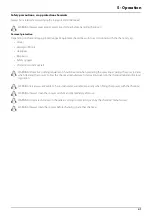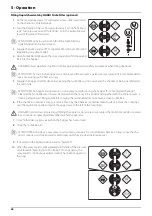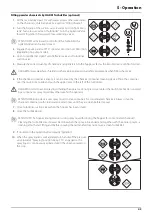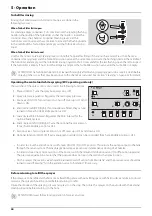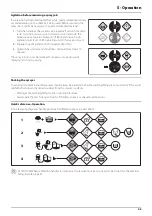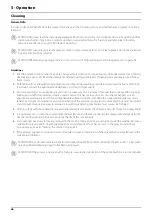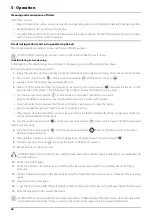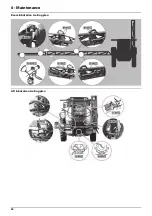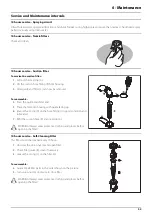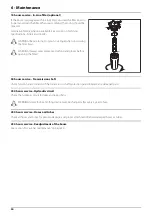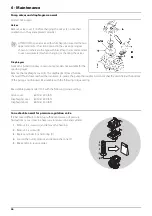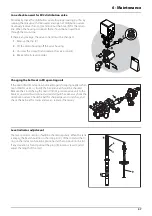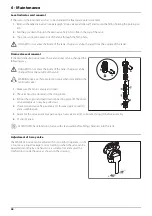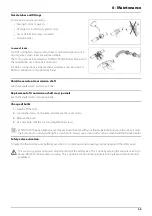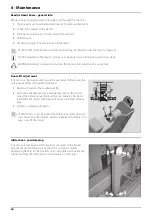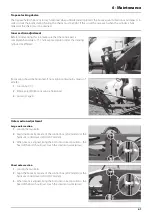
5 - Operation
46
Cleaning
General info
In order to derive full benefit from the sprayer for many years the following service and maintenance program should be
followed.
μ
ATTENTION! Always read the individual paragraphs. Read instructions for service/maintenance jobs carefully before
starting on the job. If any portion remains unclear or requires facilities which are not available, please for safety
reasons leave the job to your HARDI dealer’s workshop.
μ
ATTENTION! Clean sprayers are safe sprayers. Clean sprayers are ready for action. Clean sprayers cannot be damaged
by pesticides and their solvents.
μ
ATTENTION! Before any cleaning, please also see section on “Filling/washing location requirements” on page 38.
Guidelines
1.
Read the whole chemical label. Take note of any particular instructions regarding recommended protective clothing,
deactivating agents, etc. Read the detergent and deactivating agent labels. If cleaning procedures are given, follow
them closely.
2.
Be familiar with local legislation regarding disposal of pesticides washings, mandatory decontamination methods, etc.
If in doubt, contact the appropriate department, e.g. Dept. of Agriculture.
3.
Pesticide washings can usually be sprayed out on a soakaway. This is an area of ground that is not used for cropping.
Seepage or runoff of residue into streams, water courses, ditches, wells springs etc. must never happen. Use an
appropriate washing place with hard, impenetrable surface (concrete) and drain to an appropriate tank (e.g. slurry
tank) to avoid spot contamination and contamination of the underground water resources. Washings must be diluted
and distributed over larger areas to ensure biological degrading. Applicable law must always be followed.
4.
Cleaning starts with the calibration, as a well calibrated sprayer ensures the minimal amount of remaining spray liquid.
5.
It is good practice to clean the sprayer immediately after use and thereby rendering the sprayer safe and ready for the
next pesticide application. This also prolongs the life of the components.
6.
It is sometimes necessary to leave spray liquid in the tank for short periods, e.g. overnight, or until the weather becomes
suitable for spraying again. Unauthorized persons and animals must not have access to the sprayer under these
circumstances. See also “Parking the sprayer” on page 45.
7.
If the product applied is corrosive, it is recommended to coat all metal parts of the sprayer before and after use with a
suitable rust inhibitor.
μ
ATTENTION! It is advisable to increase the forward speed (double, if possible) and reduce the pressure to 1.5 bar when
spraying diluted remaining liquid in the field just sprayed.
μ
ATTENTION! If the sprayer is cleaned with a high pressure cleaner, lubrication of the entire machine is recommended.
Summary of Contents for MASTER PRO VHH
Page 6: ...Table of Contents 6 ...
Page 8: ...1 EC Declaration 8 ...
Page 12: ...2 Safety notes 12 ...
Page 50: ...5 Operation 50 ...
Page 52: ...6 Maintenance 52 Boom lubrication oiling plan Lift lubrication oiling plan ...
Page 70: ...7 Fault finding 70 ...
Page 76: ...8 Technical specifications 76 Charts Boom hydraulic Z ...
Page 78: ...8 Technical specifications 78 ...
Page 82: ...HARDI INTERNATIONAL A S Helgeshøj Allé 38 DK 2630 Taastrup DENMARK ...


